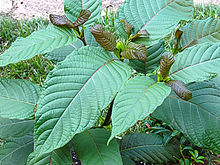The American Botanical Council Guide to the DEA’s targeting of Kratom
November 15, 2016
 by John Weeks, Publisher/Editor of The Integrator Blog News and Reports It is likely safe to state that, like me, most greeted with “Say what?” the August 2016 news that the US Drug Enforcement Administration (DEA) used its emergency powers to immediately place an obscure herb, kratom, in a Schedule 1 category. Unless one has an opioid addiction, is a botanicals expert, or is 20-years-old and exploring any substance that might bring an altered state, the DEA’s presumed act of public protection might as well have been an announcement of a shield against aliens. Worse than cocaine and methamphetamine? Public outcry from over 145,000 at a White House petition site – more protesting that it has medicinal value - plus a letter from 51 members of Congress forced a DEA retraction. Now the agency and the public are marching toward the December 1, 2016 termination of a public comment period the DEA ultimately granted. The American Botanical Council (ABC) has published a welcome guide to the tree, its traditional medicinal uses, and the debate over more recent uses recreationally and by individuals with pain conditions. The article by Connor Yearsley, entitled “Kratom: Medicine or Menace?”, is available freely to non-members of ABC. The 12 pages, replete with
by John Weeks, Publisher/Editor of The Integrator Blog News and Reports It is likely safe to state that, like me, most greeted with “Say what?” the August 2016 news that the US Drug Enforcement Administration (DEA) used its emergency powers to immediately place an obscure herb, kratom, in a Schedule 1 category. Unless one has an opioid addiction, is a botanicals expert, or is 20-years-old and exploring any substance that might bring an altered state, the DEA’s presumed act of public protection might as well have been an announcement of a shield against aliens. Worse than cocaine and methamphetamine? Public outcry from over 145,000 at a White House petition site – more protesting that it has medicinal value - plus a letter from 51 members of Congress forced a DEA retraction. Now the agency and the public are marching toward the December 1, 2016 termination of a public comment period the DEA ultimately granted. The American Botanical Council (ABC) has published a welcome guide to the tree, its traditional medicinal uses, and the debate over more recent uses recreationally and by individuals with pain conditions. The article by Connor Yearsley, entitled “Kratom: Medicine or Menace?”, is available freely to non-members of ABC. The 12 pages, replete with  numerous photos of Mitragyna speciosa, covers the waterfront. A sidebar speaks to traditional use among Thai laborers. They reportedly chew the leaves for ongoing energy, apparently in the way that Andean people have historically used coca leaves. The effect on humans is described as “increased alertness, sociability and sometimes increased libido.” A rare human trial found effects that range from giddiness and euphoria to loss of motor control and nausea. Use of the herb as part of a “cocktail” for recreational purposes is described. Readers learn elsewhere of Lyme’s disease sufferer and a veteran’s use of the leaf as a tea, in lieu of opioids, for pain reduction. A leading researcher notes that, in the United States, “people are overwhelmingly using the herb medically and not as a recreational psychotropic.” Dependency is noted, but not presented as alarming. Mark Swagger, PhD, a co-author of a qualitative study of 161 users found “kratom has some addiction potential” but that “overall it is mild compared to common opioid addiction.” A co-author of a separate review of the pharmacology of the plant, Walter Prozialeck, PhD, is quoted as saying that “the amount that a person has to take in order to get any adverse effects is ridiculously high.” He found “more positive aspects than negative aspects.” A toxicologist was hired to examine the reported deaths – a total of 15 between 2014 and 2016 associated with the herb. These were a principal cause for the DEA action. “In each case,” the toxicologist “disputed the notion that kratom toxicity was the cause of death.” Typically, the more probable causes were existing conditions or other substances taken concurrently.
numerous photos of Mitragyna speciosa, covers the waterfront. A sidebar speaks to traditional use among Thai laborers. They reportedly chew the leaves for ongoing energy, apparently in the way that Andean people have historically used coca leaves. The effect on humans is described as “increased alertness, sociability and sometimes increased libido.” A rare human trial found effects that range from giddiness and euphoria to loss of motor control and nausea. Use of the herb as part of a “cocktail” for recreational purposes is described. Readers learn elsewhere of Lyme’s disease sufferer and a veteran’s use of the leaf as a tea, in lieu of opioids, for pain reduction. A leading researcher notes that, in the United States, “people are overwhelmingly using the herb medically and not as a recreational psychotropic.” Dependency is noted, but not presented as alarming. Mark Swagger, PhD, a co-author of a qualitative study of 161 users found “kratom has some addiction potential” but that “overall it is mild compared to common opioid addiction.” A co-author of a separate review of the pharmacology of the plant, Walter Prozialeck, PhD, is quoted as saying that “the amount that a person has to take in order to get any adverse effects is ridiculously high.” He found “more positive aspects than negative aspects.” A toxicologist was hired to examine the reported deaths – a total of 15 between 2014 and 2016 associated with the herb. These were a principal cause for the DEA action. “In each case,” the toxicologist “disputed the notion that kratom toxicity was the cause of death.” Typically, the more probable causes were existing conditions or other substances taken concurrently.  Yearsley leans on perspectives of David Kroll, PhD, a pharmacologist and science writer who is a member of ABC’s global Advisory Board. Kroll concludes that “the DEA rushed to judgement … without fully investigating that its compounds were pharmacologically distinct from strong opioid agonists [e.g. morphine].” To severely restrict access to kratom at this time would “stall the scientific study of the herb at a time when our understanding of its molecular pharmacology has never been more advanced and promising.” Comment: Of course, in “stalling the scientific study,” the DEA would effectively be removing from more rapid exploration a potentially valuable tool in the nation’s battle against opioid abuse. It is difficult to not have the DEA’s continued prejudicial classification of marijuana as Schedule 1 in mind on reading this. No medicinal value? More harmful than cocaine and methamphetamine? In the case of kratom, as with cannabis, the imprisonment in Schedule 1 – or in the case of kratom, attempted imprisonment – is difficult to explain as a judicious sentence based on science. Yearsley’s exceptionally balanced, educational reporting is eye-opening. He strips the DEA action down until the emperor stands naked, except for a big question mark. Why was the DEA seeking to clang shut what would effectively be a dungeon gate on this potential contributor to limiting opioid abuse?
Yearsley leans on perspectives of David Kroll, PhD, a pharmacologist and science writer who is a member of ABC’s global Advisory Board. Kroll concludes that “the DEA rushed to judgement … without fully investigating that its compounds were pharmacologically distinct from strong opioid agonists [e.g. morphine].” To severely restrict access to kratom at this time would “stall the scientific study of the herb at a time when our understanding of its molecular pharmacology has never been more advanced and promising.” Comment: Of course, in “stalling the scientific study,” the DEA would effectively be removing from more rapid exploration a potentially valuable tool in the nation’s battle against opioid abuse. It is difficult to not have the DEA’s continued prejudicial classification of marijuana as Schedule 1 in mind on reading this. No medicinal value? More harmful than cocaine and methamphetamine? In the case of kratom, as with cannabis, the imprisonment in Schedule 1 – or in the case of kratom, attempted imprisonment – is difficult to explain as a judicious sentence based on science. Yearsley’s exceptionally balanced, educational reporting is eye-opening. He strips the DEA action down until the emperor stands naked, except for a big question mark. Why was the DEA seeking to clang shut what would effectively be a dungeon gate on this potential contributor to limiting opioid abuse?



















SHARE